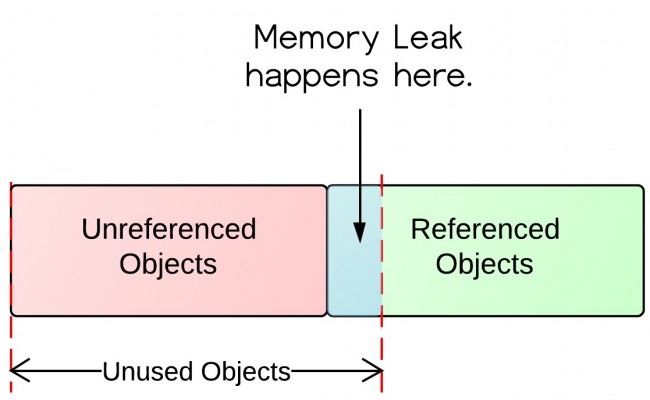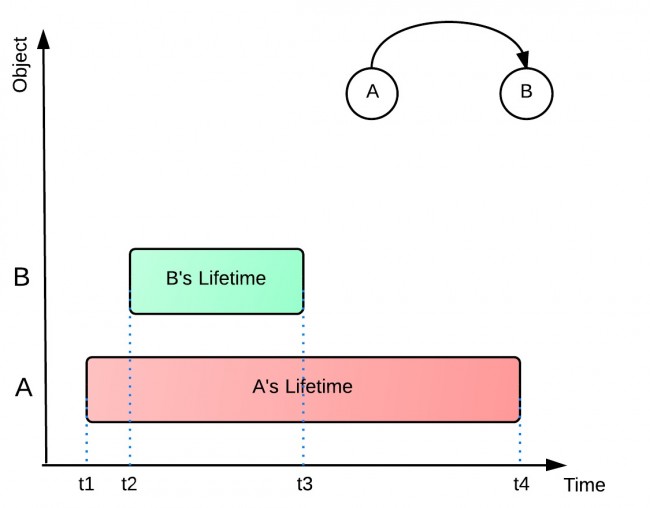The Introduction of Java Memory Leaks
One of the most significant advantages of Java is its memory management. You simply create objects and Java Garbage Collector takes care of allocating and freeing memory. However, the situation is not as simple as that, because memory leaks frequently occur in Java applications.
This tutorial illustrates what is memory leak, why it happens, and how to prevent them.
1. What is Memory Leak?
Definition of Memory Leak: objects are no longer being used by the application, but Garbage Collector can not remove them because they are being referenced.
To understand this definition, we need to understand objects status in memory. The following diagram illustrates what is unused and what is unreferenced.

From the diagram, there are referenced objects and unreferenced objects. Unreferenced objects will be garbage collected, while referenced objects will not be garbage collected. Unreferenced objects are surely unused, because no other objects refer to it. However, unused objects are not all unreferenced. Some of them are being referenced! That's where the memory leaks come from.
2. Why Memory Leaks Happen?
Let's take a look at the following example and see why memory leaks happen. In the example below, object A refers to object B. A's lifetime (t1 - t4) is much longer than B's (t2 - t3). When B is no longer being used in the application, A still holds a reference to it. In this way, Garbage Collector can not remove B from memory. This would possibly cause out of memory problem, because if A does the same thing for more objects, then there would be a lot of objects that are uncollected and consume memory space.
It is also possible that B hold a bunch of references of other objects. Those objects referenced by B will not get collected either. All those unused objects will consume precious memory space.

3. How to Prevent Memory Leaks?
The following are some quick hands-on tips for preventing memory leaks.
- Pay attention to Collection classes, such as HashMap, ArrayList, etc., as they are common places to find memory leaks. When they are declared
static, their life time is the same as the life time of the application. - Pay attention to event listeners and callbacks. A memory leak may occur if a listener is registered but not unregistered when the class is not being used any longer.
- "If a class manages its own memory, the programer should be alert for memory leaks."[1] Often times member variables of an object that point to other objects need to be null out.
4. A little Quiz: Why substring() method in JDK 6 can cause memory leaks?
To answer this question, you may want to read Substring() in JDK 6 and 7.
References:
[1] Bloch, Joshua. Effective java. Addison-Wesley Professional, 2008.
[2] IBM Developer Work. http://www.ibm.com/developerworks/library/j-leaks/
The Introduction of Java Memory Leaks的更多相关文章
- Find out when memory leaks are a concern and how to prevent them
Handling memory leaks in Java programs Find out when memory leaks are a concern and how to prevent t ...
- On Memory Leaks in Java and in Android.
from:http://chaosinmotion.com/blog/?p=696 Just because it's a garbage collected language doesn't mea ...
- Diagnosing out of memory errors and memory leaks 内存泄露实例 C Java JavaScript 内存泄露
小结: 1. 数据库连接池. JDBC语句和结果对象必须显式地关闭. 2. 电梯到目标楼层后地址是否被释放 When a button is pressed: Get some memory, whi ...
- Debugging Java Native Memory Leaks
GZIP造成JAVA Native Memory泄漏案例 https://www.elastic.co/blog/tracking-down-native-memory-leaks-in-elasti ...
- Java Memory Management(1)
Java Memory Management, with its built-in garbage collection, is one of the language’s finest achiev ...
- 内存泄露 Memory Leaks
什么是内存泄露 内存管理一直是Java 所鼓吹的强大优点.开发者只需要简单地创建对象,而Java的垃圾收集器将会自动管理内存空间的分配和释放. 但在很多情况下,事情并不那么简单,在 Java程序中总是 ...
- Activitys, Threads, & Memory Leaks
Activitys, Threads, & Memory Leaks 在Android编程中,一个公认的难题是在Activity的生命周期如何协调长期运行的任务和避免有可能出现的内存泄漏问题. ...
- Is there a way to avoid undeployment memory leaks in Tomcat?
tomcat 项目部署问题 - yshy - 博客园http://www.cnblogs.com/yshyee/p/3973293.html jsp - tomcat - their classes ...
- 内存泄漏 Memory Leaks 内存优化 MD
Markdown版本笔记 我的GitHub首页 我的博客 我的微信 我的邮箱 MyAndroidBlogs baiqiantao baiqiantao bqt20094 baiqiantao@sina ...
随机推荐
- trade 1.0 开源工具
dapper.net T4PocoGenerator/ Dapper.ColumnMapper 参考链接: http://blog.csdn.net/ymnets/article/details/85 ...
- delphi图形图像开发相关
①delphi的图形处理(doc) http://wenku.baidu.com/view/519df09951e79b89680226ee.html ②delphi的图形图像处理(ppt) http ...
- itertools模块速查
学习itertools模块记住这张表就OK了 参考:http://docs.python.org/2/library/itertools.html#module-itertools Infinite ...
- 深入剖析——float之个人见解
浮动的原本作用仅仅是为了实现文字的环绕效果. 以下分别是html与css代码,显示效果如下图.因为两个div使用了float浮动属性,所以脱离了标准文档流.让父元素撑开高度,我们需要清除浮动. < ...
- 删除或清空具有外键约束的表数据报-ERROR 1701 (42000)
OS: centos 6.3 DB:5.5.14 mysql> select database();+------------+| database() |+------------+| sa ...
- iOS 进阶 第十二天(0413)
0413 - Quartz2D 使用Quartz2D画图形步骤:(drawRect: 方法 是 在view第一次显示到屏幕上的时候会调用一次.是系统主动去掉用的,不能直接调用.那么问题来了,比如我要通 ...
- iOS点击cell查看大图,点击大图还原小图-b
一.项目需求 用collectionView展示很多照片,点击某个照片,用全屏scrollView无限循环的方式查看图片.点击放大的图片,图片缩小到原先的尺寸. 如图gif1.gif所示,点击中间的图 ...
- js eval()执行传参函数的写法
.cs public class Message<T> { // 数据总数 public int? Total { get; set; } // 关键数据 public List<T ...
- Javascript核心概述 - 深入了解javascript
/* 一.执行上下文:堆栈(底部全局上下文+顶部当前活动上下文) */ /* 二.变量对象: 变量根据执行上下文,找到数据存储位置,这种机制叫变量对象 1. 变量都要var定义,且都不能delete ...
- CSS3属性box-shadow使用教程,css3box-shadow
CSS3的box-shadow属性可以让我们轻松实现图层阴影效果.我们来实战详解一下这个属性. 1. box-shadow属性的浏览器兼容性先来看一个这个属性的浏览器兼容性: Opera: 不知道是从 ...
